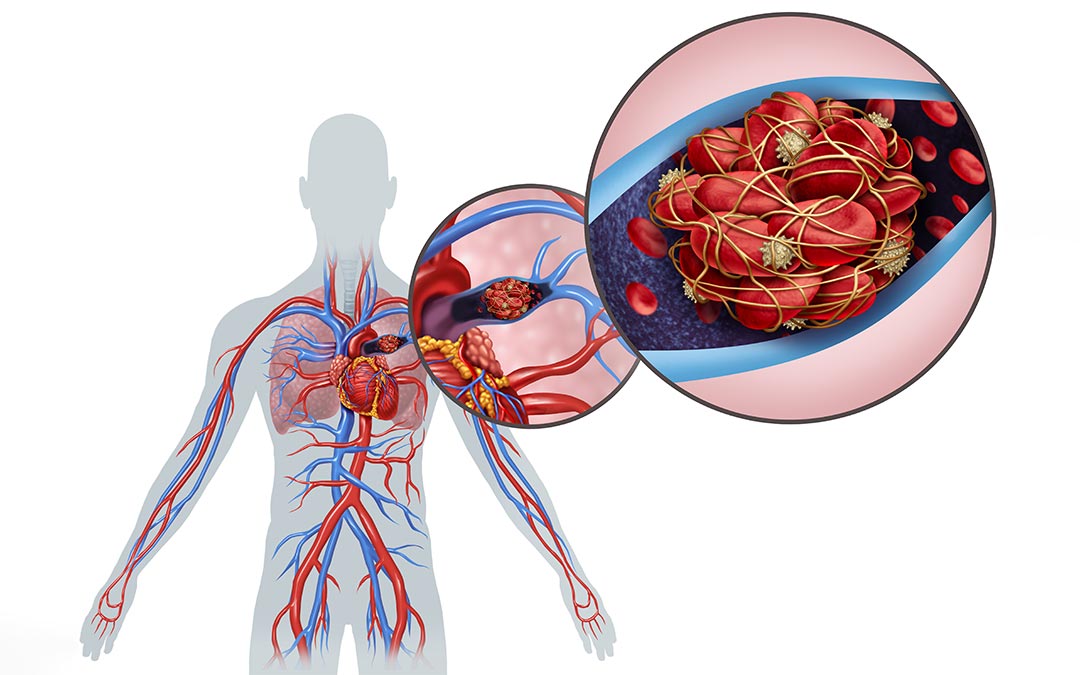Deep vein thrombosis (DVT) has been in the news for all the wrong reasons recently, leaving many confused about what it is and its causes. Let’s look at three causes of deep vein thrombosis in the general population and how to minimise the risks.
Deep vein thrombosis is a blood clot within the internal veins, not arteries, of the body. (The difference between arteries and veins: Arteries take oxygenated blood away from the heart, circulating it around the body. Veins return deoxygenated blood from the extremities to the heart). Blood clots can occur within any deep vein but most commonly in the internal leg veins.
There are many reasons why blood may clot within a vein. To understand the top 3 causes, first, we need to understand what happens to blood when it transforms from a liquid into a congealed mass.

Curdled milk gives a good demonstration of blood clotting. Milk transforms from a free-flowing liquid into a clotted, curdled mess. This is very much like deep vein thrombosis. The blood inside a vein congeals or thickens. If it forms a large enough clump, it can block the vein. This stops the blood from flowing up toward the heart, which can lead to a medical emergency or at the very least a severely painful and swollen lower leg. Put another way, a blocked vein is like having a massive car pile-up along the motorway, causing kilometres and kilometres of banked-up cars. This is what happens with a DVT, the blocked vein causes obstruction of blood flow up the major vein highway.

Blood clots can affect the lungs
A blood clot (particularly in the leg) is most severe and dangerous when it dislodges, travels up the vein carried by normal blood, into the right side of the heart and then into the large pulmonary/lung arteries. It is here that it can cause severe obstruction of blood flow to the lungs. This is called a Pulmonary (Lung) Embolism (a blood clot that has travelled from one area to another) or PE. This is a medical emergency and has a high mortality rate. The symptoms of a PE may include chest pain, shortness of breath, and fatigue.

Blood clots can affect the brain
In certain circumstances, a genetic hole in the wall of the heart that separates the right and left sides can allow for the passage of the blood clot, bypassing the lungs. It is in these circumstances that the clot can go straight into the cerebral (brain) vessels, causing a blockage of blood flow to parts of the brain. This is called a stroke and in phlebology terms, this is known as a Paradoxical Clot Embolism.
If a blood clot forms somewhere in the body (often the heart) it can travel through the bloodstream to the brain. Once in the brain, the clot will eventually become lodged in a blood vessel too small for it to pass through, stopping blood flow, causing a stroke. These kinds of strokes are called embolic strokes.
Top Causes of Deep Vein Thrombosis
- Immobility
- Trauma
- Thrombophilia (genetic vulnerability)
Immobility
Blood can congeal and cause a blood clot in situations where an individual is immobilised, not moving their body, or using their leg muscle pump (walking or running) to help blood flow through the deep veins efficiently. These situations may include long haul flights or car trips, long periods in bed due to illness or hospitalisation, or perhaps the leg has been immobilised by a plaster cast following a fracture.
Trauma
Major trauma because of major surgery, a major car or motorbike accident, can result in internal bleeding. Sometimes the body’s mechanisms can overcompensate to stop the bleeding resulting in blood clotting inside the deep veins of the body.
Thrombophilia
Where there is no other aggravating factor, such as immobility and trauma, a genetic predisposition to blood clotting may underlie most cases of thrombosis. However, many patients with increased genetic susceptibility to clots (such as people with the Factor V Leiden gene mutation or Prothrombin Gene Mutation) may develop a blood clot only in a time of stress or when there is an exacerbating factor such as smoking or taking the oral contraceptive pill. If you have a first-degree family member who is diagnosed with an underlying gene defect, it is important to discuss this with your GP who may advise testing for the gene mutation.
Does the rare blood clotting condition linked to a COVID-19 vaccine work this way too?
The evidence currently suggests the rare formation of blood clots following a COVID-19 vaccination, referred to as vaccine-induced prothrombotic immune thrombocytopenia (VIPIT), relates to platelets and not to the traditional causes of deep vein thrombosis we have discussed here.
Key Takeaways
- Deep vein thrombosis is a blood clot in the veins.
- When blood thickens, it can create a clot large enough to block blood flow inside vessels and cause a medical emergency.
- A blood clot is most dangerous when it is carried to the heart, lungs, or brain. This can be life-threatening.
- Three main causes of deep vein thrombosis are:
- Immobility: due to travel or being confined to a bed in the case of illness
- Trauma: due to major surgery or a major vehicle accident
- Thrombophilia: a genetic predisposition to clotting which may be exacerbated by smoking or taking the oral contraceptive pill.






